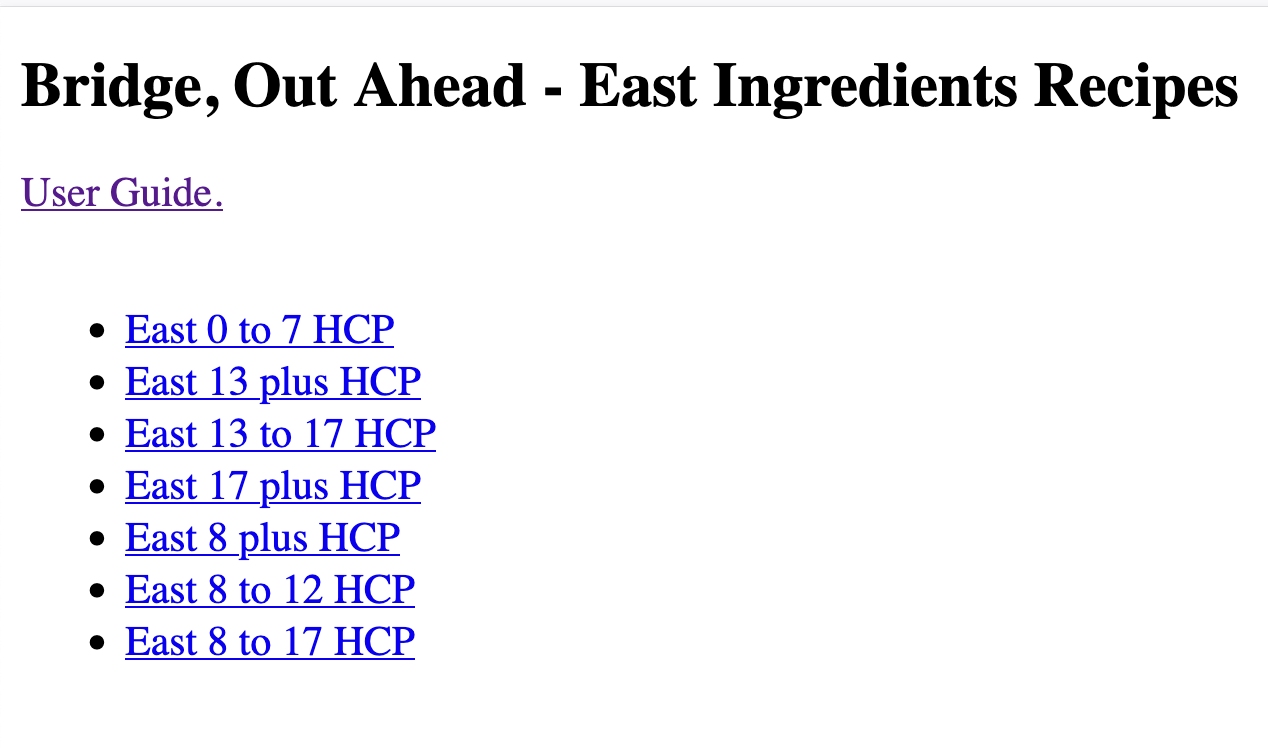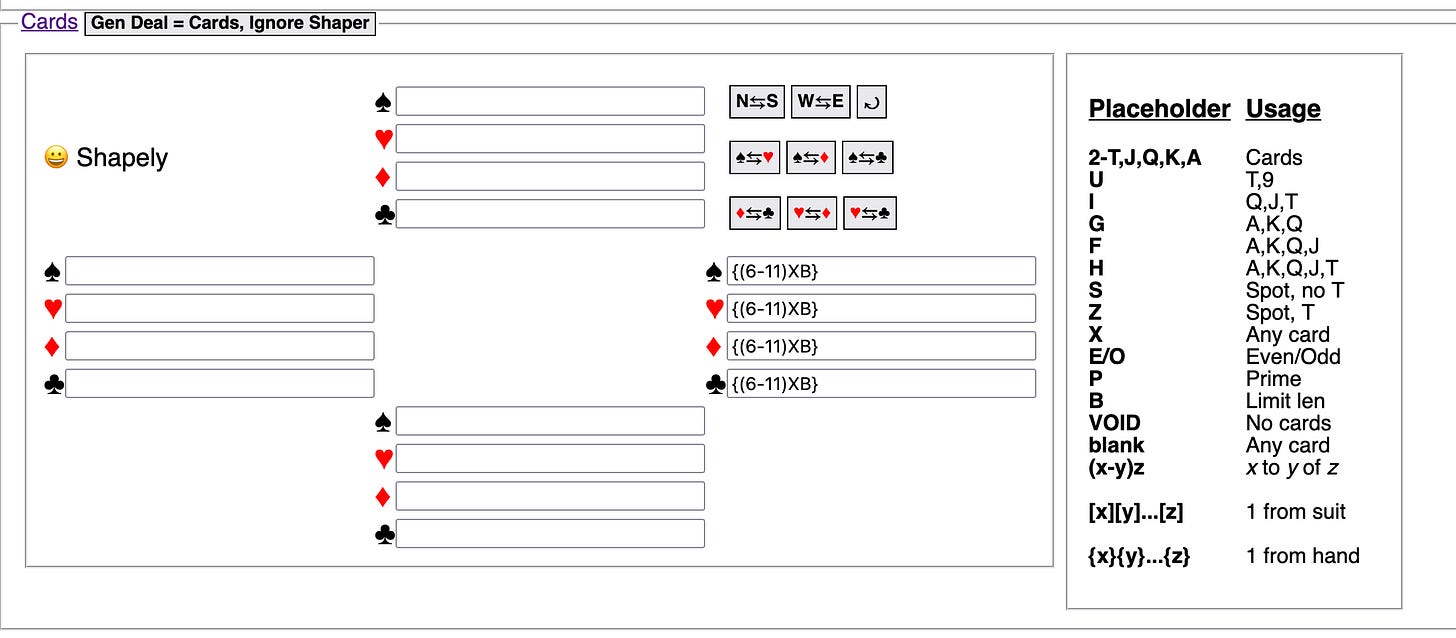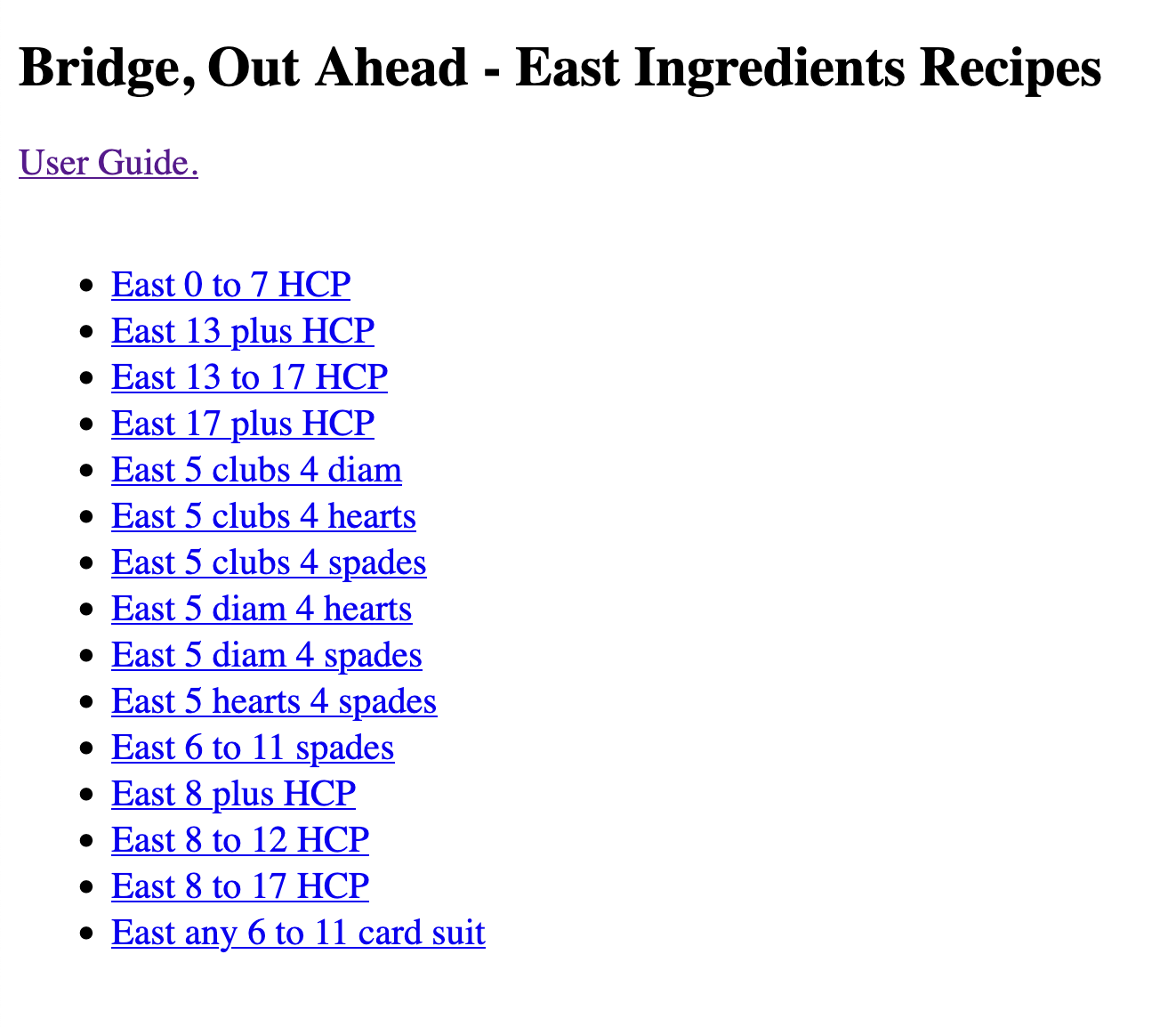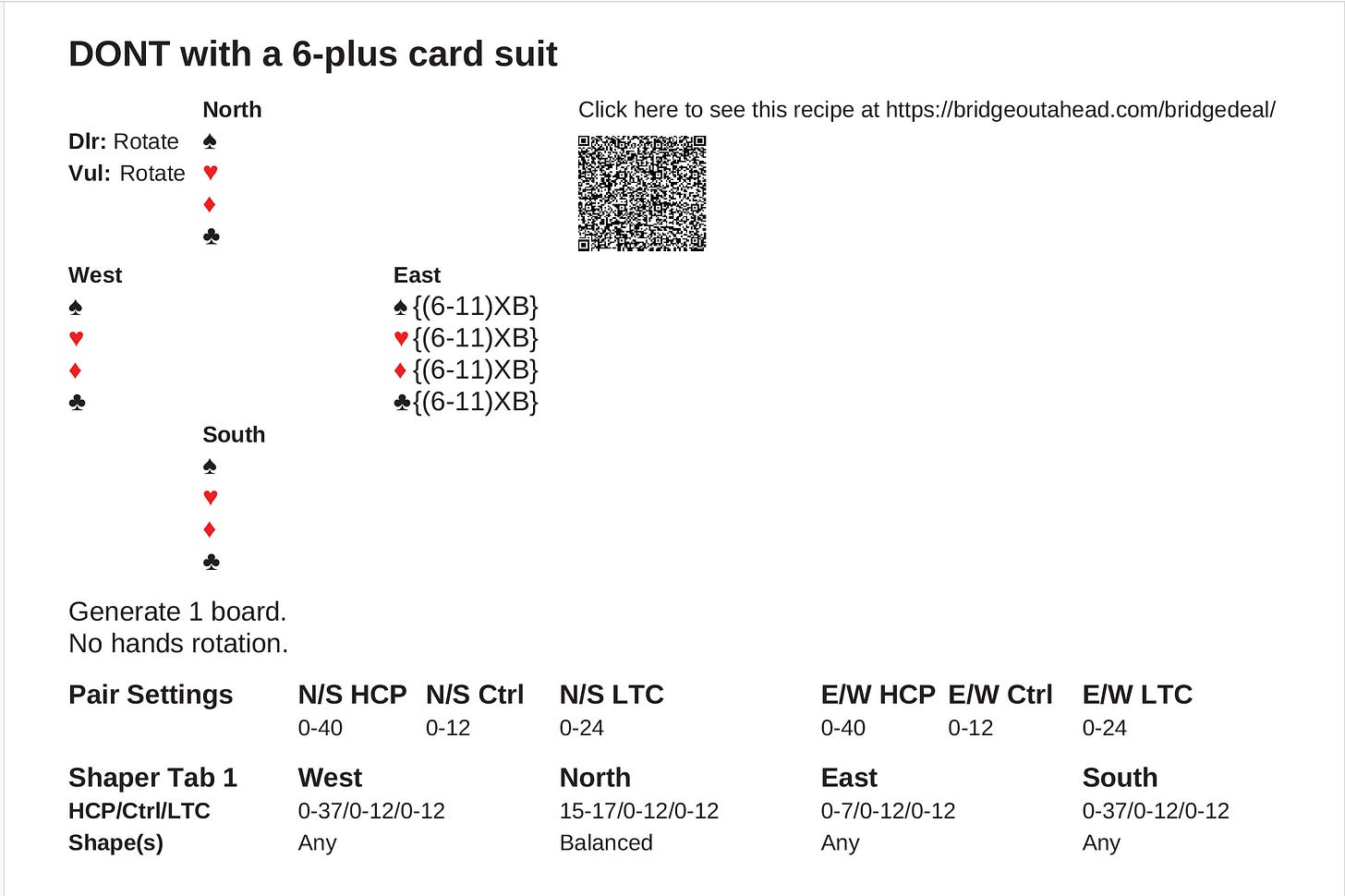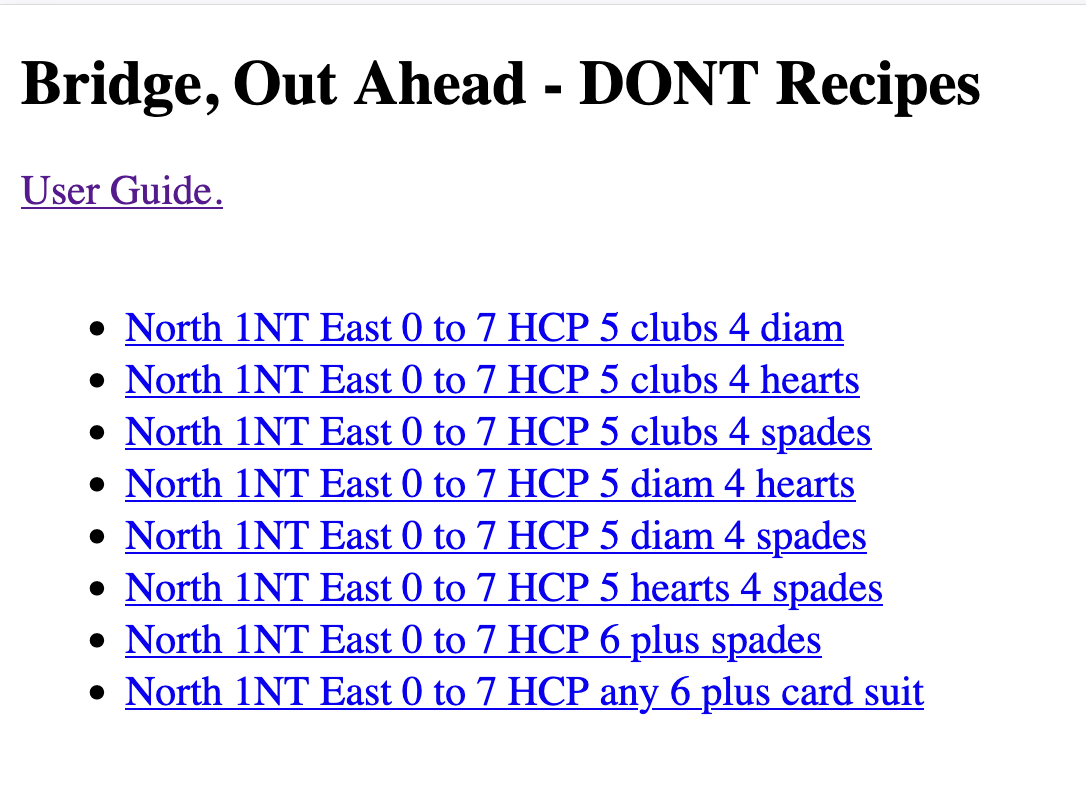Hi, bridge pals.
This post is about the process of building recipes to illustrate the DONT convention. If you just want the recipes without the explanation, start here and follow links until you find the DONT recipes. That first page also gives you a link with which you can download my entire cookbook to your computer, instead of accessing recipes one at a time via web pages.
Long ago, before the deal generator had reached its current level of marvelosity, in two blog posts I laid out some incredibly convoluted steps for making deals for the DONT convention. I don’t recommend looking at those old blog posts for their bridge content, but you might enjoy seeing my old color schemes, based on the late, great Microsoft Hot Dog Stand theme, plus my seasonal red and green Christmas theme (those themes are coming back to the deal generator, BTW—I just don’t know when).
Today, recipe construction is a lot easier. I will show you some easy DONT recipes in the latter half of this blog post. But first, since we’re still in the early days of me building and sharing my bridge deal cookbook, we need some more ingredients. I have already built out a nice starter set of recipes for opening deals, here. The 1NT opener recipes will be essential starting points for DONT recipes.
A DONT bid is a type of overcall. Since my current set of opening bids are all from the North, we will want East to have a DONT-worthy hand. So, before thinking about DONT, let’s define a few East ingredients, which are recipes that have some useful characteristic but which don’t define a complete bid or convention.
Overcaller Point Range Ingredients
Here, I have built a few recipes whose only function is to define HCP ranges for East.
You may recognize some common HCP ranges that come up in discussions of overcalls, whether natural or conventional. There is nothing DONT-specific about these East ingredients. Since we’re starting with a blank slate in some hands, I am simply creating ingredients that will be useful for any number of bidding scenarios.
DONT Hand Shapes
Those of you who rode the Technology Train 2025 heard me speak about turning bridge language into deal recipes. I made that the first topic of my presentation because it’s not just part of the challenge of making good instructional deals—it’s the whole challenge. So let’s focus on language for a bit.
You not only need a tool that lets you express bridge language in a systematic way, but you also need to pay very close attention to the wording used in defining the convention.
DONT, as presented by some authors, consists of interfering when you have a 6-card suit, or when you are 5-4 in two suits. Not much call for interpretation there. But I like to use Bridgebum.com as my source, and for DONT they use phrases like, “6+ cards” and “at least 5-4 or 4-5”.
“6+” takes a lot more care than does a simple 6-card suit. Why? Because, given the fact that we want to Disturb Opponent’s No Trump, the opponent must have a 1NT opener, which implies at least 2 cards in every suit, assuming the standard definitions of a balanced hand. So in the context of DONT, when we see that we can have a 6+ card suit, we must understand that to mean 6-11 cards. No worries! We can define that in the Cards panel, like this:
Likewise, “5-4 or 4-5” would be very easy to define, but “at least 5-4 or 4-5” opens up a lot more possibilities. If you define a hand that has something longer than 5-4 in two suits, and if you define it too rigidly (say, by specifying some very long suits in the Cards section of a recipe), you might once again use up too many cards in a suit such that opener can’t have a 1NT hand.
The question arises (and not just for recipe construction but also for thinky thoughts): given the phrase “at least 5-4 or 4-5,” what is a reasonable limit on the lengths of our two suits? And if one suit is very long, at what point do we consider our hand 1-suited, and bid solely based on that suit?
For me, when I am new to a convention, a perfectly reasonable course of action is to define the simplest case first. For that reason, I am going to only build two-suited recipes that are 5-4 in two suits, with the 5-card suit being the lower ranking. Future generations (like you all, or probably me in the next week or so) can work out the other scenarios implied by “at least”.
So now, based on the above discussion, I have built out my East ingredients. Remember, these are still not complete recipes—they are just my attempts to convert parts of the convention language into ingredients. Therefore, you still see the East HCP range ingredients I defined earlier, now joined by (but not touching or combined with—yet) the East card distributions.
You might be wondering if you have to go through so much preparation every time you set out to write a recipe for a scenario or convention. The answer is NO! All of this prep work is intended to save future labor, both for myself and for anyone who uses my cookbook. Yes, you will encounter situations where you have to do a lot of your own analysis and you might have to construct highly detailed recipes from scratch. But if you try to think in terms of components (ingredients) and define and save those things the first time you need them, then you will have them forever.
Enough prep work! Let’s make our DONT recipes.
At Long Last, DONT
It pains me to not give you screen prints of each step, but I committed to not doing that in hopes that you will use the user guide to learn how to do the things I mention here. But I’m not a monster: if you want a video or personal tutorial, just ask.
For my first DONT recipe, I loaded my recipe for a 1NT opener in North. Then I merged in the East ingredient recipe for 0-7 HCP. Then I merged in the East ingredient recipe giving East any 6-plus card suit. This resulted in this recipe, shown here in report form:
So now you might think that building each recipe requires me to first load in an opening hand recipe, then layer in multiple overcall ingredients via the merge function. Not so, if you make several recipes in one session, and if you are organized. After making the above recipe, I then—in super-organized fashion—merged in first my East ingredient recipe where East has 5 clubs and 4 diamonds. I didn’t need to merge in the East 0-7 HCP recipe because it was already in my Shaper panel from when I made the first full-on recipe. I saved the resulting 5-club 4-diamond recipe to a file.
Then I repeated the process with each of my other carefully constructed East hand shapes, merging in 5 clubs and 4 hearts, saving that recipe; then merging in 5 clubs and 4 spades and saving that recipe, and so on. Then I did the same with my 5 diamond ingredients, 5 heart ingredients, and then my 6-spade ingredient.
I then made all of that into a cookbook, as detailed in the user guide. Here’s what the cookbook page looks like:
Yes, it only defines the DONT hands for 0 to 7 HCP, and it only defines hands with exactly 6 cards in a suit, or exactly 5 in one suit and 4 in a higher ranking suit. It is not the complete DONT convention. But it’s a darn good start. My next step will be to merge in a different East HCP range ingredient recipe, such as the 8-12 HCP range, then make 8 more recipes with the card distributions shown above. If I feel the need for other point ranges, I’ll define those recipes as well.
That still only covers the simple cases with 5-4, two-suited. But, once I have those recipes at hand, I will have a good basis for exploring the “at least 5-4 or 4-5” scenarios.
Happy dealing!

